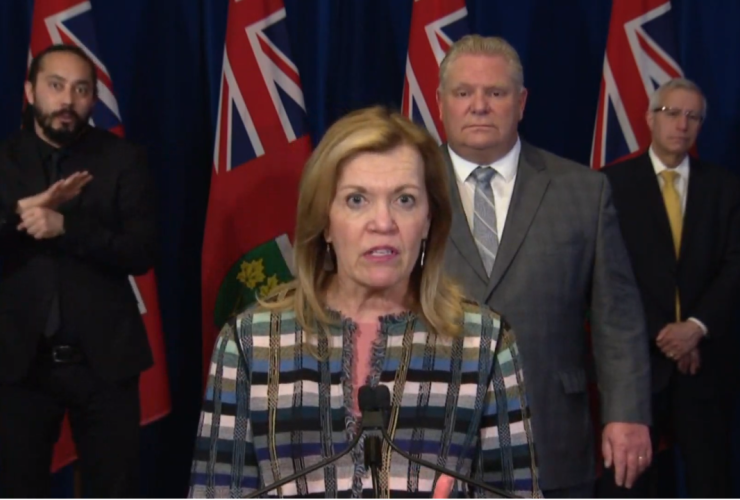The bad news: 80,000 people in Ontario could get COVID-19 by the end of April if the current trajectory continues, according to projections released Friday by the province. Of those, 1,600 could die.
The good news: If Ontario introduces even stricter physical-distancing measures now and does every single thing it can, those numbers can be greatly reduced, with a best-case scenario of 12,500 cases and 200 deaths over the next month, the projections show.
And it could have been worse. Without the steps the government has already taken, there could have been 300,000 cases and 6,000 deaths by the end of the month, roughly two deaths every hour.
"I realize that to many people, these will be shocking figures," said Dr. Peter Donnelly, president and CEO of Public Health Ontario, who cautioned the models are predictions used to inform government decisions, and they may change over time.
The pandemic could last up to two years, Donnelly said. Depending on how strictly Ontario follows public health measures, between 3,000 and 15,000 people in the province could die over that period, the models show.
"There is a range because where we end up depends on all of us," Donnelly told reporters at the briefing. "We are following a trajectory similar to the United States."
"Had we done nothing, Ontario may have suffered 100,000 deaths," he added, referring to the total course of the pandemic. "Thankfully, that is not the position we're in."
Public health officials warn that Friday's predictions aren't set in stone and don't necessarily predict the future. Short-term projections are more certain than long-term ones, Donnelly said, and the numbers from today will undoubtedly change day by day.
Death numbers tend to more reliable than positive cases because of differences in testing strategies, and the models rely on assumptions that people are doing their best to keep themselves and their loved ones safe. The predictions are based on data about how the novel coronavirus that causes COVID-19 spreads, as well as other countries' experiences.
In response to the projections, Ontario Premier Doug Ford announced he would shut down even more businesses Friday, narrowing his list of essential workplaces to halt industrial construction. There will be no new residential construction allowed, but necessary hospital construction and other critical work will be permitted to continue, he said.
"These numbers are stark," said Ford, who added that he hopes the numbers are a wake-up call for those who aren't taking the pandemic seriously. "They are sobering."
To put the numbers in perspective: Every year, about 1,350 people in Ontario die from seasonal flu, Donnelly said. In a bad year, that can rise to 1,500. COVID-19 has a mortality rate that's 10 times higher, Donnelly added.
Donnelly also noted that Ontario appears to be behind British Columbia in terms of limiting new infections. He urged Ontarians to "stay focused" and not lose their grip on physical-distancing measures. And if we don't, it's possible the virus could surge again and cause a second wave of cases, or even a third wave.
“We need to bear down," he said.

Ford and public health officials repeated pleas for Ontarians to stay home, and not leave their homes except for essentials. Though Toronto has a weekend of sunny spring weather in the forecast, the premier asked residents to avoid parks and other people.
"We all have to ask ourselves: What is the cost of a life?" Ford asked. "Is a life worth having a few cold ones with your buddies?"
Though Donnelly said stricter health measures would be needed, he and the premier stopped short of calling for a full lockdown. If stores selling essentials like food and medication were to close, it would cause "anarchy," Ford said, and it would be very difficult to police travel restrictions, especially as officers fall ill and self-isolate.
"Our resources are spread thin right now," Ford said.
Instead, Donnelly said, Ontarians can expect more business closures and heightened physical-distancing guidelines in stores. The province is also working on more intensive contact tracing — the process used by public health officials to find out who an infected person may have been in contact with.
Ontario has also resolved its long-standing backlog of people waiting for the results of COVID-19 tests, which swelled to nearly 11,000 last week. Getting rid of the logjam is crucial, Donnelly said, allowing officials to see how many new infections are appearing and to begin testing more strategically.
As of Friday morning, Ontario has 3,255 COVID-19 cases and 167 deaths related to the novel coronavirus. Another 1,023 people have recovered. Of those with active cases, 462 have been hospitalized, with 194 in the intensive care unit (ICU) and 140 of those on ventilators.
ICU capacity may be enough — if we all stay home
Right now, Ontario has 410 free ICU beds available for COVID-19 patients, in addition to the ones that are already occupied. Capacity is currently at 70 per cent across the province.
Projections by the province show ICU spaces could run out in a matter of two or three days. However, the province expects to open up 900 more spaces in short order, said Matthew Anderson, president and CEO of Ontario Health. And under the best-case scenario projections, Ontario expects to have enough spaces.
If people don't practise physical distancing, however, the need for ICU beds could jump rapidly.
"If the need was to spike, that becomes very difficult for us," Anderson said.

The province is also looking at opening up more spaces, in addition to the 900, as well as key medical equipment, like ventilators. Officials are also working to make sure those resources are where patients need them or that patients can be moved to where they can be treated properly, Anderson said.
Adalsteinn Brown, dean of the Dalla Lana School of Public Health at the University of Toronto, said at Friday's briefing that Ontarians must stay vigilant.
"I think it’s important to convey the seriousness of the threat … this is a disease that can rear back very quickly," he said.
Doris Grinspun, the CEO of the Registered Nurses' Association of Ontario (RNAO), which represents the province’s registered nurses, nurse practitioners and nursing students, said ventilators are in more danger of running short than ICU spaces. But Grinspun said Ontario must also take care to ensure there are enough front-line nurses at the ready.
About 700 credentialed nurses are waiting to be deployed now, but officials seem unaware that a surge of cases could soon cause staffing shortages, Grinspun said. If those nurses aren't deployed in the next few days, she said, Ontario risks having problems similar to hospitals in Italy, which have been hard hit by the virus and have struggled with staffing levels.
"The time to move them into the workplaces is now, not next week," she said. "Chaos will set in if you do not have surge capacity ... Now is the time to act."
Data released by the province Friday also showed that seniors continue to be most vulnerable to the deadly virus. The fatality rate for Ontario residents aged 80 and over is just under 16 per cent. For those 60 to 79, the fatality rate is just under three per cent, as opposed to 0.6 per cent for people aged 40 to 59. (No deaths have been recorded in Ontario for COVID-19 patients under 39.)
We are in a critical moment, Ontario. We must all do our part. Stay home. pic.twitter.com/8ec8N7z1k2
— Doug Ford (@fordnation) April 3, 2020
More businesses told to close
Friday afternoon, the Progressive Conservative government issued a new list of non-essential businesses that must close amid the pandemic.
The new construction restrictions exclude "critical projects" like roads, hospitals and bridges. Petrochemical construction and work on refineries are also allowed to continue.
Other stores are now allowed to operate by curbside pick-up and delivery only. That list includes retailers that sell hardware products, vehicle parts and supplies, pet and animal supplies, office supplies and computer products and repairs.
Donnelly suggested that eventually, some restrictions on physical distancing will be lifted — it's unlikely that people will be asked to stay home for the entire two-year duration expected of the pandemic. But we are a long way from seeing those rules removed, he added.
"I think it’s important that we are all robustly realistic about the challenges we face."
Editor's Note: This story was updated at 3:39 p.m. and again at 6:19 p.m. to include more information from the Province of Ontario and from the RNAO.
All of this is true. However,
All of this is true. However, it is starting to come off as the government patting itself on the back for having done so much. Look to BC to see how to behave, Mr Ford.
On April 5th the Surgeon
On April 5th the Surgeon General of the US said that even under their worst case projections, more Americans will die of tobacco related illness than of COVID19.
The economic collapse we are facing will have a far more detrimental effect on our society and will ultimately result in far more deaths than COVID19.
Wake up Canada! We are being manipulated.






Comments